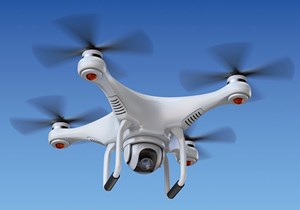Scottish Water taps leading-edge drones and lasers to improve sewer network
(UC) — Scottish Water is enhancing its sewer network and reducing carbon emissions by using "state-of-the-art" drones and lasers.
State-of-the art drones and lasers are being used together for the first time in Britain to improve Scotland’s sewers and are helping Scottish Water to reduce its carbon emissions.
A combination of hi-tech drones and laser technology adapted for use in the wastewater industry is being deployed by the utility to survey sewers for potential problems by flying the drones inside them, often to parts of the network that traditional surveying methods can’t reach.
“This is the first time we’ve used drones adapted for sewers and LiDAR together for sewer surveys and we are really excited about it,” Iain Jones, risk and life cycle planning manager at Scottish Water, said. “We want to improve the accuracy of our surveys and, for safety reasons, we want to reduce the number of workers needed to carry out survey work inside sewers. The drone does both and they will also help us in our aim to reach net zero carbon emissions by 2040.”
Using the new techniques will enable the water company to more accurately assess the sewers’ condition and make key decisions about investment in maintenance or rehabilitation work to improve them.
This will, in turn, make the sewers more resilient, improve Scottish Water’s service to customers, and reduce the risk of leaks, collapses and environmental pollution.
Replacing teams of up to 15 workers with just two operatives using drone and Light Detection and Ranging (LiDAR) scanning and measurement techniques will also reduce carbon emissions from sewer surveys by as much as 80%, helping Scottish Water towards its target of reaching Net Zero Carbon emissions by 2040.
In a move which uses bespoke drones to fly into sewers, effectively replacing workers in challenging and dangerous underground conditions, the innovative application of the two technologies will enable Scottish Water to survey its network of more than 33,000 miles of sewers more accurately.
The more accurate surveys will cut the cost of repairs and maintenance, reduce the risk of flooding and pollution, improve the utility’s ability to target investment, and enhance workers’ safety.
Many of the sewers, some dating back to the Victorian era, have previously been difficult to access but much more of the network is now reachable following the collaboration between Scottish Water, its alliance partner Caledonia Water Alliance (CWA), civil engineering trenchless specialist Environmental Techniques and drone manufacturer Good Friday Robotics.
The adapted technology was used together for the first time on a large brick sewer in Bath Street in Glasgow city center in July and is set to be rolled out and used at other locations in Glasgow, Edinburgh, Aberdeen and some rural areas.
Sewer inspections, which seek to identify issues such as cracks, holes, partial collapses, infiltration, and root ingress, are needed to enable Scottish Water to make decisions on investment and the earlier any repairs and maintenance work is carried out, the lower the costs are to the company.
With the aim of improving sewer surveys and making them safer by reducing the number of workers needed to go below ground, Environmental Techniques, which provides trenchless drainage inspection, cleaning, and rehabilitation services to the water industry, have developed the drones and associated software with CWA and Good Friday Robotics.
The drones and LiDAR provide substantially better video quality, defect confirmation and location accuracy than traditional techniques.
LiDAR is a laser scanning tool that measures distances, and the associated software creates an accurate computerized 3D point field output which can be viewed on-screen. The drone carries the LiDAR and camera onboard as it flies inside the pipe.
A worker controls or pilots the drone as it flies along the pipe and uses video for visual inspection and LiDAR for measurement. The outputs are then manually reviewed by operators to spot and code the defects.
The drones were adapted specifically for sewers and are made of carbon fiber to reduce their weight and extend battery life.
Scottish water is efficiently using this technology to make significant carbon savings by not using any plant and people resources unnecessarily. Those who would have been doing these surveys in a traditional ‘worker-entry’ way will be redeployed to other tasks where their skills can still use be leveraged.
“Factors such as depth, flows and debris can significantly slow down a worker entry survey in a way that does not affect the drones,” Jones said. “Because of the reduction in the number of workers involved, a large number of site vans and vehicle deliveries are not required and so carbon emissions are reduced.”
Related News
From Archive

- Texas A&M weighs underground transit plan with Elon Musk's Boring Co. to reduce campus traffic
- Lynchburg, Va., breaks ground on largest-ever Blackwater CSO tunnel project
- Wyo-Ben’s Max Gel, Max Bore HDD system boost drilling efficiency, performance
- Federal court halts permits for 32-mile Tennessee gas pipeline project
- Cadiz to reuse steel from terminated Keystone XL pipeline for California groundwater project
- Wisconsin proposes new PFAS drinking water standards to align with federal rules
- Dog River pipeline replacement in Oregon improves water supply with new HDPE pipe
- Leaking wastewater systems named top source of San Diego River contamination, study finds
- New Portable Welding System From Miller
- Excavator Causes Puerto Rico Power Outage




Comments